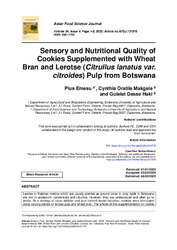Sensory and Nutritional Quality of Cookies Supplemented with Wheat Bran and Lerotse (Citrullus lanatusvar.citroides) Pulp from Botswana
Date
2025-06-03Author
Emesu, Pius
Makgale, Cynthia Oratile
Haki, Gulelat Desse
Metadata
Show full item recordAbstract
Lerotse or Kalahari melons which are usually planted as ground cover in crop fields in Botswana are rich in potassium, carotenoids and citrulline. However, they are undervalued and often go to waste. As a strategy of value addition and post-harvest waste-reduction, cookies were formulated using varying blends of lerotse pulp and wheat bran. The effects of this supplementation on cookie acceptability and nutritional quality were determined through sensory evaluation and Nutri-Score calculation, respectively. Bran cookies without lerotse supplementation (the control sample) received low overall liking of 5.9. However, increasing the lerotse-to-bran ratio from 0.25 to 4.0 resulted in an increase in overall liking from 5.8 to 7.65, with a significant difference (P =.05). Significant differences were was also observed between the samples in terms of aroma, while other sensory properties did not differ significantly amongst all samples at P =.05. The Nutri-Score classification changed from A (dark green) in the lerotse-free cookies to B (green) in samples with lerotse-to-bran ratio of 0.25 and to C (yellow) in samples with lerotse-to-bran ratio between 0.67 and 4.0. For lerotse-containing cookies, a Nutri-Score rating of B represents good nutritional quality while a rating of C indicates moderate nutritional quality. Therefore, incorporating lerotse and wheat bran at a ratio of 0.25 produced a moderately liked product of good nutritional quality. Further optimization of the formulation could be achieved through chemical and physical characterization, potentially leading to commercially viable products that would increase lerotse utilization.
Collections
- Reseach articles [146]

